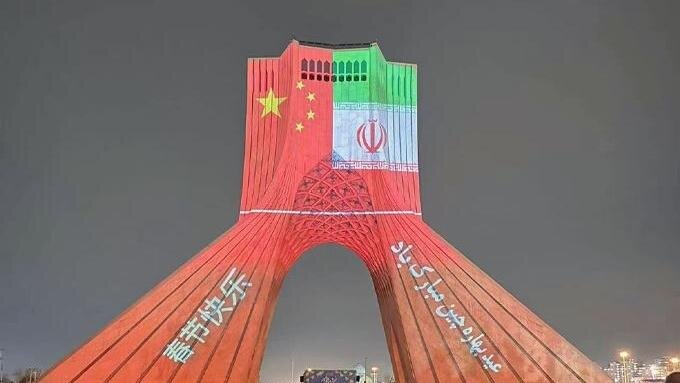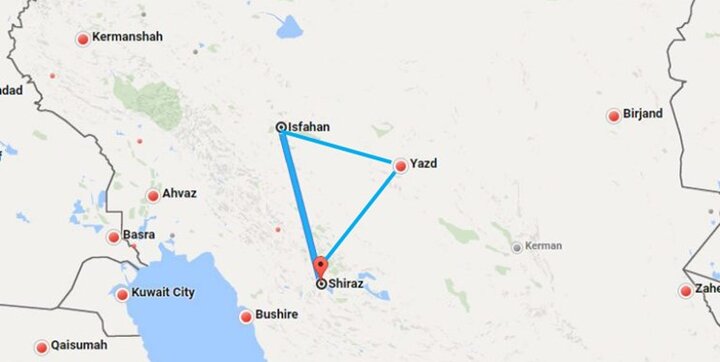Chinese Spring Festival opportunity for Iran’s golden triangle of tourism, expert says

TEHRAN – China’s Spring Festival more commonly known as the Chinese New Year opens a window of tourism opportunity for Iran’s s golden triangle of tourism, a travel expert said on Monday.
The golden triangle, encompassing Kerman, Yazd, and Isfahan, presents a captivating tapestry of cultural heritage, architectural wonders, and natural landscapes.
“The provinces of Yazd, Fars, and Isfahan, recognized as the country’s golden triangle of tourism, can benefit from the opportunity provided by the Chinese New Year celebrations in a span from the 10th to the 30th of Bahman (Iranian calendar), by holding events and joint programs to accommodate Chinese tourists,” said Moslem Shojaei who presides over the office for foreign tourism marketing and development at the Ministry of Cultural Heritage, Tourism, and Handicrafts.
Spring Festival, more commonly known in English as the Chinese New Year, is the biggest festival in China with celebrations that traditionally last for 16 days, starting from Chinese New Year’s Eve to the Lantern Festival.
Shojai made the remarks at a Tehran meeting attended by the deputy tourism minister Ali-Asghar Shalbafian, and governors-general of the provinces, IRNA reported. He said one of the measures that can be taken in this regard is to seek assistance from industrial and economic sectors to promote provincial tourism.
“When it comes to that golden triangle, the need for the participation of industrial and specialized sectors in national such as organization of familiarization tours is of high significance,” he explained.
He said the three provinces have long been traditional destinations for Chinese nationals visiting Iran. “Focusing on the Chinese New Year holidays can take advantage of the opportunity to host Chinese tourists during this period by holding joint events and presenting event-oriented programs.”
Speaking at the meeting, Mehran Fatemi, the governor-general of Yazd province, demanded governmental support for the three provinces.
“With the government’s attention and special focus on the three provinces of Yazd, Fars, and Isfahan, the path of development becomes smoother by emphasizing the strengthening of transportation and infrastructure provision,” Fatemi said.
He added considering that the three provinces of Yazd, Fars, and Isfahan are the cultural tourism destinations of the country, and most tours’ major destinations and the majority of our nationally and internationally registered monuments are predominantly located in these provinces, it is necessary to open a new chapter for joint collaborations.

Fatemi also mentioned issues such as attention to providing communication infrastructure needs, which included transportation, defining common routes and packages, establishing a joint logo, forming a special pavilion at national tourism fairs, establishing a permanent secretariat, creating a joint website, focusing on advertising and producing joint tourism content emphasizing lesser-known areas, organizing joint cultural programs and nights, and ultimately focusing on common target markets.
Placed within the heart of Iran lies a region steeped in history, culture, and architectural marvel, Iran’s golden triangle of tourism beckons travelers with its rich heritage, mesmerizing landscapes, and a tapestry of ancient wonders waiting to be discovered.
Kerman, the gateway to the southeastern part of Iran, presents an intriguing mix of history and natural beauty. It boasts the awe-inspiring Kaluts—majestic sand formations sculpted by the wind over centuries—in the Lut Desert, a UNESCO World Heritage site. Travelers can marvel at the exquisite craftsmanship in the historic Ganjali Khan complex and the mesmerizing Shahdad Desert.
Kerman embraces cultural diversity with open arms, hosting various ethnic communities, each contributing to the region’s vibrant heritage. Visitors can immerse themselves in the enchanting ambiance of traditional bazaars, such as the Grand Bazaar and the Vakil Bazaar, where echoes of ancient trade routes still resonate.
Yazd, renowned for its architectural marvels and as the embodiment of Persian heritage, stands as a testament to the ingenuity of its people. The city is a labyrinth of wind towers, adobe structures, and intricate mosques, including the UNESCO-listed Jameh Mosque and the Amir Chakhmaq Complex. Wander through the historic Fahadan neighborhood, adorned with narrow alleys and mud-brick homes, offering a glimpse into Iran’s past.
Moreover, Yazd is synonymous with Zoroastrianism, one of the world’s oldest religions. The Towers of Silence and its ancient fire temples are sacred sites where visitors can explore the spiritual and cultural roots deeply ingrained in the city’s identity.
Isfahan, the crowning jewel of Iran’s cultural heritage, captivates with its opulent palaces, grand mosques, and UNESCO-recognized Naqsh-e Jahan Square. This bustling square is surrounded by architectural marvels such as the Imam Mosque, Sheikh Lotfollah Mosque, and the Ali Qapu Palace, showcasing the pinnacle of Safavid-era design.
The city’s historic bridges, notably the iconic Si-o-Se Pol and Pol-e Khaju, provide an atmospheric setting for strolling and taking in panoramic views of the Zayandeh-Rud river. Isfahan’s vibrant bazaars, including the Grand Bazaar and the Qeisarieh Bazaar, offer a treasure trove of Persian handicrafts, textiles, and spices.
From the ethereal beauty of desert landscapes to the intricate details of ancient cities, this cultural triangle invites travelers on an unforgettable journey through Iran’s rich history and vibrant traditions.
AFM
Leave a Comment